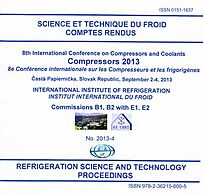
Document IIF
Contrôle des fuites de frigorigène appliqué au R-290 dans des systèmes frigorifiques et de conditionnement d'air de type split.
Refrigerant leakage control for R-290 in split type refrigeration and air conditioning systems.
Numéro : pap. n. 36
Auteurs : COLBOURNE D., HÜHREN R., RAJADHYAKSHA D. D., et al.
Résumé
Safety standards are often cited as the major barrier to using hydrocarbon (HC) refrigerants in medium to large capacity split-type air conditioning and refrigeration systems. Whilst the otherwise technical aspects associated with the application of HCs are attractive – high potential efficiency, good material compatibility, compact systems, etc – their use is often hindered due to the obstructive charge size formulas within safety standards. Regrettably, these current requirements neglect to consider that other measures could be applied to system design and operation to prevent flammable concentrations occurring, even with the charge size exceeding prescribed values. This article offers a number of design features involving sensing methods and mitigation actions which can reduce leak quantities and floor concentrations. Experimental work is presented and results included for a variety of different leak conditions and combinations of sensing methods and mitigation actions. Lastly, a method is proposed for routine laboratory testing of equipment in order to determine leaked quantity and effectiveness of the integrated safety concepts.
Documents disponibles
Format PDF
Pages : 10 p.
Disponible
Prix public
20 €
Prix membre*
Gratuit
* meilleur tarif applicable selon le type d'adhésion (voir le détail des avantages des adhésions individuelles et collectives)
Détails
- Titre original : Refrigerant leakage control for R-290 in split type refrigeration and air conditioning systems.
- Identifiant de la fiche : 30008916
- Langues : Anglais
- Source : Compressors 2013: 8th International Conference on Compressors and Coolants.
- Date d'édition : 02/09/2013
Liens
Voir d'autres communications du même compte rendu (60)
Voir le compte rendu de la conférence
Indexation
-
Dispersion of flammable refrigerants from split...
- Auteurs : COLBOURNE D., BUTLER D.
- Date : 25/07/2000
- Langues : Anglais
- Source : Final proceedings of the 4th IIR-Gustav Lorentzen Conference on Natural Working Fluids at Purdue.
- Formats : PDF
Voir la fiche
-
R290 leakage mass flow rate from a refrigeratin...
- Auteurs : COLBOURNE D., LIU Z. X.
- Date : 25/06/2012
- Langues : Anglais
- Source : 10th IIR-Gustav Lorentzen Conference on Natural Working Fluids (GL2012). Proceedings. Delft, The Netherlands, June 25-27, 2012.
- Formats : PDF
Voir la fiche
-
The simulation of the leaking distribution char...
- Auteurs : CAI D., HE G., TANG W., et al.
- Date : 02/08/2014
- Langues : Anglais
- Source : 11th IIR Gustav Lorentzen Conference on Natural Refrigerants (GL2014). Proceedings. Hangzhou, China, August 31-September 2, 2014.
- Formats : PDF
Voir la fiche
-
Safe design of R290 ducted air-conditioning equ...
- Auteurs : COLBOURNE D., ARANGO A., DICKSON E., et al.
- Date : 18/06/2018
- Langues : Anglais
- Source : 13th IIR Gustav Lorentzen Conference on Natural Refrigerants (GL2018). Proceedings. Valencia, Spain, June 18-20th 2018.
- Formats : PDF
Voir la fiche
-
Minimum airflow rates to dilute R290 concentrat...
- Auteurs : COLBOURNE D., SUEN K. O.
- Date : 18/06/2018
- Langues : Anglais
- Source : 13th IIR Gustav Lorentzen Conference on Natural Refrigerants (GL2018). Proceedings. Valencia, Spain, June 18-20th 2018.
- Formats : PDF
Voir la fiche
